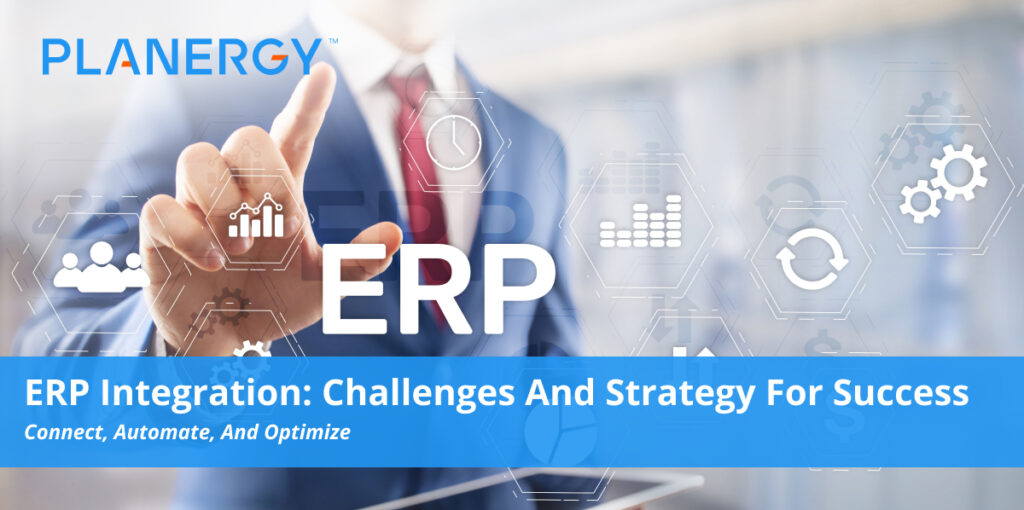In today’s fast-paced and highly competitive economy, companies need every advantage they can get to stay ahead of the curve.
Enterprise resource planning (ERP) software provides businesses of all sizes and types the power to automate workflows, integrate and standardize their software environments, and provide a centralized data management solution that improves communication and collaboration. There are many different examples of how ERP software can be used.
Not all ERPs are created equal and often requirements will change after the initial implementation. Changing functionality or adding new functionality in an ERP can be very costly and time consuming.
Often incorporating an external software dedicated to a specific area can be a better approach to extending your ERP.
In order to take advantage of this power, however, companies need to invest the time and resources necessary to ensure successful ERP implementations that truly meet their business needs.
With a thorough understanding of what ERP integrations are, how they work, and the common integration challenges that can stymie your efforts to integrate and optimize, you can craft an ERP integration strategy that will help you rise above the roadblocks to success.
What Is ERP Integration?
Businesses use enterprise resource planning software to consolidate their data management and business process optimization efforts, connecting disparate business units such as accounting, marketing, customer service, and production. ERP applications are designed to prioritize and facilitate automation, connectivity, and data integration.
By extension, then, the term “ERP integration” refers to the way in which this consolidation, standardization, and cross-functional collaboration is achieved by incorporating external software with your ERP. At its most basic, an ERP integration can be described as a kind of central hub into which you can “plug” all your other software.
Some of the systems connected by a typical ERP integration solution include (but aren’t limited to):
- Customer relationship management (CRM)
- Procure-to-pay (P2P) software
- eCommerce platforms
- Electronic data exchange (EDI)
- Inventory, supply chain, and supplier relationship management software
- Human resources platforms
- Production scheduling
- Business Intelligence
- Project management software
- Social media platforms
Regardless of the specific applications connected, ERP systems are designed to give team members role-appropriate access to clean, complete, consistent, and clear data drawn from disparate sources in real time.
ERP integration solutions use process automation, artificial intelligence, and advanced analytics to speed and streamline business processes while simultaneously improving their accuracy.
By reducing human error and the need for human involvement in tedious, time-consuming, and repetitive tasks, ERP software also allows team members to direct their time and talents to tasks that generate greater value and savings for their organizations.
They can be implemented in several different ways, and your approach to integrating with an ERP solution will largely depend on your unique business capabilities, needs, and budget.
- Point-to-Point Integrations connect the ERP platform to each application individually, using distinct integrations. This method has a relatively low learning curve and entry point, but can quickly grow complex as more applications are added.
- Custom-Built Integrations are built by the companies using them, connecting individual applications with the ERP solution with proprietary application program interfaces (APIs). As with point-to-point, the degree of control is high, but the need to develop custom connectors for every integrated application adds not only complexity, but additional expense.
- Enterprise Service Bus (ESB) integrations provide a centralized software hub (referred to as a communication bus) that acts as an information interchange for all connected applications, automatically handling data integration and data transfer. Adding new applications and tools is much simpler, as the ESB integration platform automatically integrates them without the need to modify the existing software environment or create additional adapters.
- Integration Platform as a Service (iPaaS) integrations are based on the software as a service (SaaS) model, replacing a single application with a platform designed to allow users to manage an array of integrated applications. In its current form, it works best for integrating cloud-based services, and may be used in tandem with a more robust solution such as ESB, which provides more comprehensive integration across business functions, in companies that still rely on some older tech or require on-premises installations for security.
Regardless of the specific applications connected, ERP systems are designed to give team members role-appropriate access to clean, complete, consistent, and clear data drawn from disparate sources in real time.
Overcoming Common ERP Integration Challenges
Despite the demonstrable improvements they provide to collaboration, communication, and organizational performance, companies can and do run into a huge variety of barriers during an ERP implementation.
And while research indicates an estimated 60% of all ERP implementations fail, that doesn’t mean yours has to be one of the unlucky majority. Understanding the common challenges that accompany an ERP integration is the first step to mitigating or negating them effectively.
1. ERP Integrations are Complex
Depending on the level of sophistication required to meet the company’s business needs, ERP implementations can involve a wide array of overlapping considerations.
Developing an ERP strategy and choosing an ERP solution may require a diverse skill set and a team drawn from multiple areas inside and outside your business. You’ll certainly need to bring IT together with the key stakeholders in your business units to identify the functionality required to meet business needs.
In addition, mastering the ERP system itself may require significant training. You’ll likely encounter resistance from stakeholders at multiple levels and across business units who are concerned about the time, training, and expense involved in making the switch.
You can mitigate this challenge by educating the C-suite on the benefits the ERP integration will provide and securing their full support prior to putting your ERP implementation strategy into action. Provide management with a clear timeline, full cost/benefit analysis and risk assessment to bring them into the fold.
With senior management on board, you’ll have a built-in team of ERP evangelists ready to provide guidance and inspiration to the rest of the organization. They’ll also be able to provide direct leadership and feedback to the ERP implementation team who are executing your strategy.
Finally, sharing the timeline with key stakeholders at all levels before beginning the implementation can allow you to collaborate and coordinate so everyone can get up to speed with education and training to support the new system as needed.
2. ERP Integrations Can Be Costly
Large organizations implementing an ERP system can find themselves making a significant upfront investment that carries both direct costs (the software itself) and indirect costs (training, support, maintenance, etc.).
Companies can reduce both direct and indirect costs of their ERP integration by looking for a purpose-built, modular system whose pricing and performance meet both their business needs and their budget.
Prioritizing integration of core business processes (such as procure-to-pay) across the organization first and then scaling to integrate other business units can help reduce expenses.
This approach is particularly helpful for businesses who want to prioritize liquidity and speed ROI for large investments, since optimizing P2P (with a solution such as PLANERGY, for example) will begin to generate immediate savings and value for the organization through process optimization, automation, and improved access to actionable insights that drive more strategic decision-making.
In addition, while ERP integrations can use cloud-based or local software, cloud-based solutions are becoming the norm due to improved security and performance, mobile-friendly architecture, and lower local resource demands.
In fact, cloud-based ERP integration solutions may be especially attractive to companies integrating legacy applications that use proprietary formatting or lack their own integration capabilities.
Shifting the functions originally performed by these legacy systems can reduce costs while simultaneously improving performance, generating savings and value that help support organizational growth and protect business continuity.
3. Customizability Can Be a Double-Edged Sword
The same modularity and customizability that make a purpose-built ERP integration so financially attractive can conceivably be an obstacle to integration if there’s a high need for intricate and granular customization at multiple levels across the organization.
Companies who want custom integrations can dodge this particular bullet by finding an ERP provider who has both intuitive and extensive customization capabilities, coupled with top-notch training, support, and service.
The implementation will be much smoother, team members will have the tools and training they need to navigate the new system, and risk will be reduced by balancing business needs against technical capabilities.
Best Practices for a Successful ERP Integration
Each business has its own specific goals and benchmarks for success. However, every organization can give itself a leg up when pursuing a successful ERP implementation and integration by following a few simple best practices.
1. Choose the ERP Integration Platform that Fits Your Business Needs
Whether you’re using point-to-point integrations to build a modular solution over time or jumping in with a combination of ESB and iPaaS, it’s crucial to choose a software integration method that meets your specific needs rather than offering a “one size fits all” approach.
A small business with no physical footprint but a large eCommerce platform will take a very different approach to ERP integration than a large brick-and-mortar enterprise with a long history and several legacy applications that need to be updated for the digital era.
Carefully consider your customization needs, prioritize data standardization and mutually intelligible APIs to reduce the complexity and scope of your implementation, and make sure long-term maintenance and scalability are part of your ERP implementation strategy from the beginning to avoid unpleasant surprises down the road.
2. Invest in AP Automation/P2P Software
Regardless of its capabilities, it’s likely that even the most advanced ERP integration solution will still have gaps in its features list. You can take some of the weight off the ERP team’s shoulders with a strategic investment in P2P software.
A comprehensive and cloud-based solution like PLANERGY automates and streamlines all the core processes involving your company’s spend—and so, by extension, provides the ideal starting point for real-time data management and centralization, since every dollar that flows through procurement and accounts payable supports your company’s goals.
Consider these benefits:
- Process automation with contingencies, from creation of the initial purchase order to verification and payment of the vendor invoice.
- Clean and transparent spend data that can be accessed and analyzed from any device or platform.
- Full integration with a wide range of applications and ERP platforms, reducing the complexity of the ERP integration while improving collaboration, standardization, and communication.
- Elimination of human error and less need for human intervention in high-volume, repetitive tasks (e.g., manual data entry).
- Reduced risk of fraud and maverick spend through internal spend controls and guided buying, ensuring more complete and accurate spend data.
- Improved vendor and inventory management.
- Advanced analytics and reporting tools that can incorporate data drawn from other applications via the ERP to improve strategic decision-making at the enterprise level.
3. Tap into ERP Expertise
While it’s likely no one knows your business better than your team members, when it comes to an ERP integration, it makes good sense to consider bringing in ERP experts to help guide the process along.
Your team can leverage their own expertise while allowing the consultants to serve as a kind of ERP themselves, connecting your team with the vendor and ensuring all customization and implementation measures adhere to your strategy, goals, timeline, and budget.
Get an Optimal Return on Your Investment with a Successful ERP Integration
The future is digital, data-driven, and fully integrated. Greater efficiency, profitability, and competitive strength require optimal collaboration, communication, and connections.
Make sure your business is ready for whatever comes next by investing in the tools, strategy, and training needed to drive a successful ERP integration.




